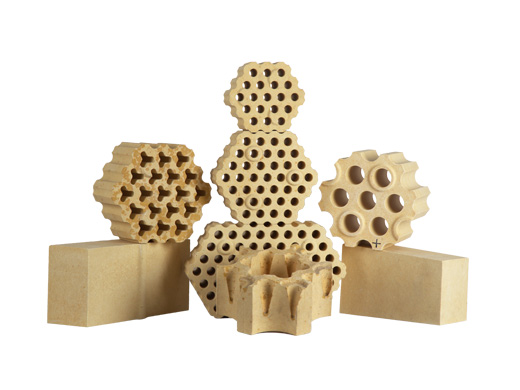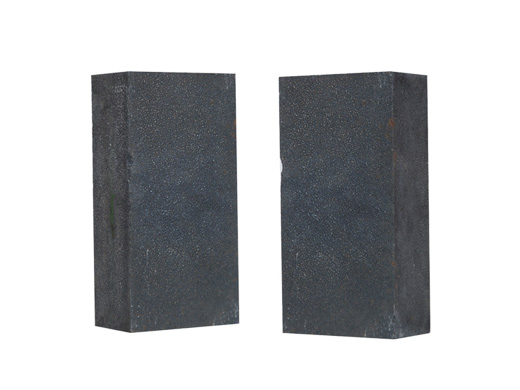Magnesite chrome brick composition process classification
Industry news | Refractory Wiki | Refractory news | Enterprise news |Magnesite chrome brick composition process classification
(1) Composition of magnesite chrome brick
Magnesia-chrome brick is an alkaline refractory product containing MgO55%-80%, Cr203 8%-20%, with periclase and composite spinel XO·Y2O3 as the main crystal phase, of which XO is mainly MgO, FeO; Y203 is mainly Cr203, Al203, Fe203. The moles of XO and Y2()3 are equal, and the excess Y203 is solid-dissolved in the composite spinel. There are also small amounts of silicate phases (forsterite and forsterite).
(2) Raw materials used and production process
Magnesite chrome brick use high-quality sintered magnesia and chromite (Cr203 30%-15%, CaO 1%-5%) as the main raw materials. The production process of magnesia bricks is generally similar to that of magnesia bricks. Unburned magnesia bricks use inorganic magnesium salt solution as binder. During the firing process, due to the loosening effect caused by the expansion of spinel when MgO reacts with CrO3, Al2O3 or iron oxides to form spinel, pre-synthesized magnesia sand can be used to make bricks, which must be fired in an oxidizing atmosphere above 1600 °C to make. If there is a change in the properties of the atmosphere, Fe2O3 in chromite is affected by the redox reaction to form various oxides of iron. At the same time, Cr2O3 is also reduced to produce different valence compounds. Under repeated reactions, the bricks will be damaged, so products with high MgO and low Cr2O3 should be used as much as possible.
According to the raw materials and process characteristics of the products, it can be divided into cast magnesia bricks, directly bonded magnesia bricks, silicate bonded magnesia bricks, recombined magnesia bricks, semi-recombined magnesia bricks, pre-reacted magnesia bricks and non-reacted magnesia bricks. Burnt magnesia bricks.
①Fused-cast magnesia brick: Fused-cast magnesia brick is a refractory product made of magnesia and chrome ore by electrofusion and pouring. The production process of fused-cast magnesia brick is shown in Figure 1. It is characterized by large and isolated pores, dense products, high strength, corrosion resistance, and sensitivity to temperature changes. The chemical properties of magnesia bricks are alkaline. Compared with magnesia bricks and porch bricks, they have good thermal vibration resistance, stable volume at high temperature, and high softening temperature under load.
②Directly bonded magnesia bricks: Directly bonded magnesia bricks are made of sintered magnesia and chromite. The SiO2 content of the raw material is required to be low, and it is fired at a high temperature above 1700 ° C to form a direct bond between the periclase and chromite particles. The typical physical and chemical properties of the directly bonded magnesia brick are: MgO 82.61%, Cr203 8.72%, SiO2 2.02%, apparent porosity 15%, and bulk density 3.08g/cm3. The compressive strength is 59.8MPa, the softening temperature under load is 1765℃, the thermal shock resistance is 1100℃ (water cooling) for 14 times, and the flexural strength is 8.33MPa.
③ Silicate combined magnesia brick: Silicate combined magnesia-chrome brick is enough to sinter magnesia and chrome ore as raw materials, and it is prepared by mixing in appropriate proportions and firing at high temperature. The mineral composition of the product is periclase, spinel and a small amount of silicate. The production of silicate-bonded magnesia bricks uses brick magnesia and general refractory chrome ore as raw materials. In magnesia, Si02<4%, Mg0>90%, Cr203 in inscribed ore is 32%-45%, and sulfite is used as the raw material. After the binder and kneading are formed, it is fired at about 1600°C. In order to prevent abnormal expansion of products during firing, a weak oxidizing atmosphere must be maintained in the kiln. The chemical composition of the product: Si02 2.98%-4.50%, MgO 61.75%-72.69%, Cr203 10.04%-14.90%. Physical properties: apparent porosity 18%-21%, compressive strength at room temperature 36.1-50.OMPa, softening temperature under load 16001640℃.
④Recombined magnesite chrome brickand semi-recombined magnesite chrome brick: Recombined magnesite chrome brick are made by re-sintering fused magnesite chrome brick sand as raw materials. Fused magnesia-chromium sand has poor sintering properties, and the product is a fine-grained matrix with uniform pore distribution and tiny cracks. Its sensitivity to temperature changes is better than that of fused cast bricks. The high temperature performance of the product is between that of fused cast brick and direct bonded brick. The typical physical and chemical properties of combined magnesia bricks are: MgO 68%, Cr203 15%, SiO2 3%, apparent porosity 14%. Bulk density 3.20g/cm3, compressive strength 52.8MPa, load softening temperature 1740℃, bending resistance Strength 7.86MPa.
Semi-rebonded magnesite chrome brick are made from fused magnesia-chrome sand and magnesia, chromite or pre-reacted magnesia-chrome sand. The product has some characteristics of re-combined magnesia-chrome brick and directly combined magnesite chrome brick or pre-reacted magnesia-inscribed brick. The typical physical and chemical properties of semi-rebonded magnesia bricks are: MgO 71.58%, Cr2O3 16.45%, Si02 2.75%, apparent porosity 13%, compressive strength 46.7MPa, load softening temperature l760℃, flexural strength 9.09MPa.
⑤Pre-reacted magnesia-chrome brick: Pre-reacted magnesia-chrome brick is made from all or part of pre-reacted magnesia-chrome sand. The production cost is lower than recombined magnesia-chrome bricks. Part of the reaction between magnesia and chromite is completed when the clinker is calcined, so the apparent porosity of the product is lower than that of the directly bonded brick with the same composition. The high temperature strength is high. The typical composition of pre-reacted magnesia-chrome brick is: MgO 62.8%, Cr203 15.3%, Si02 3.25%, apparent porosity 17%, compressive strength 51.3MPa, load softening temperature 1650℃.
⑥ Non-burning magnesia-chrome brick: The non-burning magnesia-chrome brick is made of sintered magnesia and chromite as raw materials, adding a small amount of chemical binder, and heat treatment at a lower temperature to harden the product. Some products can be hardened at room temperature, and some need to be heated to an appropriate temperature to make the products have a certain strength. When the products are used at high temperatures, they form a ceramic bond or a high temperature resistant phase. The typical composition of unburned magnesia-chrome bricks is: MgO 52.73%, Cr203 18.08%, Si02 5.0%, apparent porosity 10.9%, compressive strength 58MPa, load softening temperature 1520-1530℃.
Newest
- 2023-07-31
Properties of silicon nitride and its application in refract···...
- 2023-07-31
Properties of silicon nitride and its application in refract···...
- 2023-07-31
Properties of silicon nitride and its application in refract···...
- 2023-07-31
Properties of silicon nitride and its application in refract···...
- 2023-07-31
To explore the application of magnesia carbon brick in refra···...
Solution
- 2022-11-22
The technical requirements and production processes of fused···...
- 2022-09-06
Price Determinants of high alumina fire bricks...
- 2022-08-30
Technical performance and technology of silica mullite brick···...
- 2022-08-27
Refractory materials in various parts of the furnace and pre···...
- 2022-08-23
Magnesite chrome brick composition process classification...




